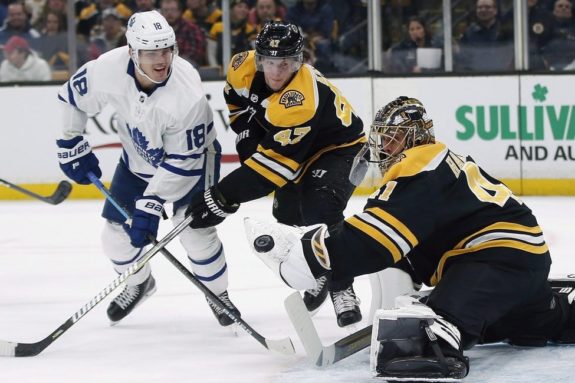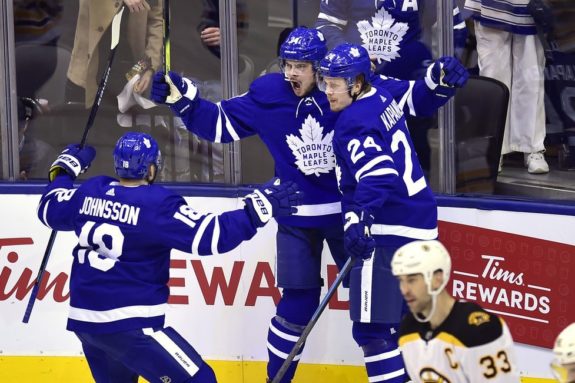The Toronto Maple Leafs had a rich season with many storylines. One of the major points to highlight from the Leafs’ 2018-19 season was Mike Babcock’s questionable usage of players. In the case of restricted free agent Andreas Johnsson, it may end up being the coaching staff’s blunder that saves them cap space.
Johnsson is one of several players on the Maple Leafs looking for a new contract worth more money. According to TSN, he turned down renewal offers throughout the season. The financials are the concerning point for the Maple Leafs.
Johnsson enjoyed a prosperous 2018-19 season, despite the up-and-down placement throughout the lineup. He appeared in only nine NHL games in 2017-18, so that sample is barely relevant, but he managed to go from 1.42 P60 to 2.49 P60. It’s worth noting that he had an exceptional 2017-18 season in the American Hockey League.

The Leafs forward was given a regular role in 2018-19 but his deployment was more sporadic than it should have been. There’s no hiding that Johnsson played significant time with Auston Matthews, which automatically boosted his numbers, but he had positive effects of his own alongside Matthews.
Johnsson and Matthews Enjoyed Success Together
Johnsson spent 52% of his 5-v-5 time playing with Matthews at an incredibly successful rate. With Johnsson and Matthews together, the Leafs controlled 55.83% of the shot attempts and scored 56.82% of the goals. Without Johnsson, Matthews’ goals-for percentage dropped just over 13% and the Leafs controlled 5% less shot attempts.
Johnsson fit seamlessly with Matthews but their time together varied during the season. Johnsson played with Matthews for eight minutes per game or more at 5-v-5 for stretches of one to six games.

At one point in the season, Johnsson had three games over eight minutes of ice time followed by one game under, then one game over, and finished with five games under. The games that were over eight were regularly near 12 minutes or higher, and the games that were lower than eight were by more than one minute. This wasn’t an isolated group of games, it was a trend during most of the season.
That mark (eight minutes) is in the ballpark range of where a player ends up when he slides on or off a top line midway through season. It wasn’t until mid-February that Johnsson became a regular on the top unit. For the remainder of the season, he spent the majority of games with north of 12 minutes TOI with Matthews at 5-v-5.
It’s hard to find any logic to the pattern of Johnsson’s use alongside Matthews prior to his full-time employment with the star. The benefits of having Johnsson with Matthews were visible during the 2018 portion of the season, so it’s puzzling that it took a veteran coach so long to figure it out.
Johnsson’s incredible offensive scoring rate of 2.49 P60 was slightly higher than players like Jack Eichel, David Pastrnak and Matt Duchene during the 2018-19 season. During 5-v-5 play, Johnsson scored more per-60-minutes of 5-v-5 ice time than each of those three players. That’s dangerous territory, if the coaching staff used him for a similar amount of TOI and his scoring rate held. Depending on whose ice time you use, you could be adding up to 20 points to Johnsson’s total.

This is where the usage misstep becomes a financial benefit for the Maple Leafs. The lack of recognition, or acknowledgement and dismissal, of Johnsson’s play will help keep his next contract down. Even as more in-depth statistical work comes to fruition, there will always be a lot of weight put on points, of which Johnsson had 43 (36 at 5-v-5).
What If Johnsson Switched Ice-Time with Marleau?
We can rule out the unrealistic scenario that Johnsson would have played the same amount of 5-v-5 minutes per game (15) as Tavares or Matthews. But we have to assume that the team’s fourth highest 5-v-5 scoring rate player deserved better than the ninth-highest TOI (among Leafs forwards).
Let’s switch Patrick Marleau’s (13:56 TOI per game) ice time with Johnsson’s. It’s reasonable to argue that Johnsson’s scoring rate warranted more minutes than he received (11:51 per game), and the Leafs could have afforded to play Marleau less. With an extra 2:05 per game, Johnsson’s 5-v-5 points go from 36 to 42, and his total points go from 43 to 49 over the 73 games.
On the power play, Marleau played 1:46 to Johnsson’s 1:34 per game. This difference is not worth much as is. The point total would increase by not even a full point if we used the Marleau power play time per game with Johnsson’s power play scoring rate.

At the negotiating table, Johnsson’s camp will act like his 43 points were 50 while the team will treat them as if they were in the 30s. There’s a large margin between 30 and 50 points in terms of where a player’s AAV will land for his next contract. The actual point total of 43 helps the Leafs and not Johnsson. At this point for the Maple Leafs, it may be the difference between affording Johnsson or not. You could probably justify any salary between $3 million-$5 million if you wanted to create a starting point for negotiations. It seems like someone will be on the move in Toronto, so this is an acceptable range that allows them to maintain control over the salary cap.
For whatever reason, it is a difficult task to find star players a good, cost-efficient, and with the chemistry to produce offensive results. When you get these players, whether homegrown or not, you try to keep them. Once you keep them, you glue them to your star player until the contract goes stale. This is the type of special find Johnsson is for Toronto.
General manager Kyle Dubas is putting a lot of hope in the historical trend across the league of avoiding offer sheets. If ever there was a year for offer sheets, it’s this one, and Johnsson would make a good candidate. With the Mitch Marner contract still pending, it could be a while before Johnsson is signed to a new deal. As contracts get signed while he waits, the bar will be set. Time is the enemy for the Maple Leafs with Johnsson, but he should still end up with a valuable contract.
*all stats via naturalstattrick.com
<div class=”send2newsPlayer”>
<div class=”s2nPlayer k-MUZeElJj” data-type=”float”></div>
<script type=’text/javascript’ src=’//embed.sendtonews.com/player3/embedcode.js?fk=MUZeElJj&cid=3020&offsetx=0&offsety=0&floatwidth=400&floatposition=bottom-right&floatwidth=400′ data-type=’s2nScript’></script>
</div>